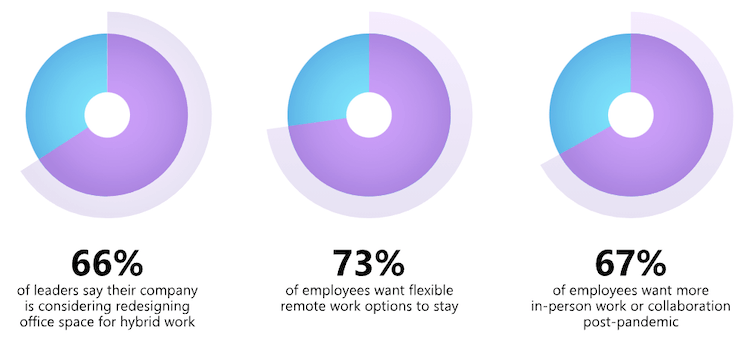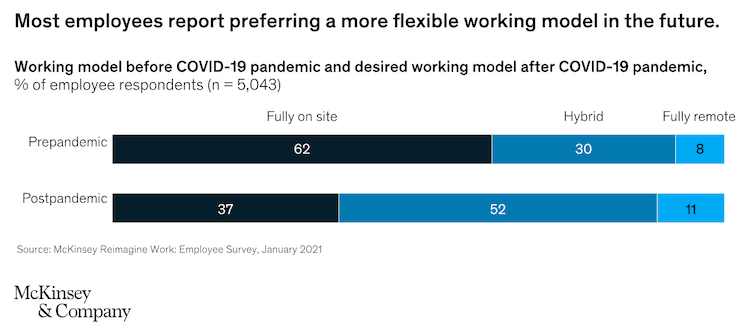Even before the 2020/2021 pandemic, some forward-thinking companies were exploring and adopting ‘work from anywhere’ (WFA) practices. Then along came lockdown, and many people had WFA, or rather WFH (‘work from home’) thrust upon them.
While some people relished not having to commute to an office, and the chance to spend more time with family and friends, others found WFH isolating, mentally challenging, and creativity-stifling.
As we come out of the pandemic, organisations are realising that there must be a middle way for the future of work, balancing between home life and office life, and that middle way is likely to be hybrid work.
What is hybrid work?
Hybrid work is a flexible working model where employees work partly in the physical workplace, and partly remotely – at home or from another workspace.
One study by Accenture found that 58% of respondents had already been hybrid working during Covid-19. These people reported better mental health, stronger working relationships, and less burnout than people who worked entirely on-site or entirely remotely. 83% said that they felt a hybrid work model would be the best one going into the future.
Do employees want the future of work to be hybrid?
Surveys, such as this one from Microsoft’s Work Trend Index 2021 show that most people are keen on keeping hybrid work post-pandemic:
 Image from Microsoft.com
Image from Microsoft.com
Another study by McKinsey backs up these findings, with 52% of employee respondents preferring a hybrid model:
 Image from McKinsey.com
Image from McKinsey.com
What are the benefits of hybrid working?
Done well, hybrid working offers a whole range of benefits for both employees and employers:
- It attracts top talent: When most employees favour hybrid working, you’ll attract and retain good, diverse ones
- It boosts your brand image: offering hybrid working demonstrates that you have a flexible forward-thinking culture with trust at its heart
- It makes employees happier: With hybrid working, employees are more in control of their lives, and their physical and mental wellbeing. Happy employees are more productive, and deliver more to the business
- It’s cheaper to run a hybrid workplace: You’ll need less outlay office space utility bills, and employees save money on commuting costs and meals
- Part-time employees feel as if they’re on a level playing field with full-time team members
The 4 types of hybrid business model
All hybrid business models blend the in-workplace and remote working experiences. But the interesting thing to note is that they have all come about by listening to what employees had to say about how they would work, the tech they needed, and how to deliver the best outcomes for the team and department.
1. Workplace-based with limited remote working
Employees are expected to connect with the office every day and attend meetings, training sessions, team briefings, and collaborations there. Sufficient tech and connectivity let people work remotely evenings and weekends, or if life events prevent them from getting to the office.
Employees who aren’t in every day miss out somewhat on the corporate culture and real-time contribution to decisions and actions.
2. Workplace-based with generous remote working
Work still revolves around a physical office, and tasks are briefed and launched from there, but employees can work from home for a set number of days per week. People can take home work that they can focus on independently, but the office is still available when collaborative working is needed, or when teams need to align.
3. Digital first with a workplace
The business maintains a physical office, but this is not its hub: the tech is. Leadership, collaboration, productivity, and culture are mainly delivered via digital tools, which can be used anywhere in the world. The norm is working from home, the exception is getting together in person in a workspace.
4. Digital first with no workplace
Everything in this model is done digitally: it employs a truly distributed workforce, with no permanent workplace, although office space may be rented as required. Tech has to be top of the range for this model to work smoothly, and colleagues may not meet in person very often.
What’s the difference between hybrid work and hybrid work from home?
Although these terms sound very similar, there are different working models:
- Hybrid work: employees divide their working week between being in the office and working remotely – this is flexible working.
- Hybrid work from home: Some employees work remotely, while other employees work in the office. Someone designated WFH will work remotely most of the time, while a WFO employee will be in the office most of the time.
eBook: The HR leader’s success kit to enabling a remote workforce
Creating the best hybrid work environment
It’s not enough to tell your employees to go away and split their working week between home and the office – that’s a recipe for chaos. Hybrid working needs careful orchestration if everyone, employees, business, and customers are to benefit. And there are some pitfalls to be aware of before you even start:
Can we be fair to everybody?
Will everybody in the business be offered a hybrid working arrangement? If not, how will it affect those who cannot be offered one?
Can we be inclusive?
It’s well known that there’s a behavioural bias towards people who are more often in the office, and therefore visible and influential, over remote workers who are ‘out of sight, out of mind’. People who do remote work are often women, people with disabilities or neurodiversities, or carers, which means that discrimination against your remote workers can contravene diversity and inclusion legislation.
Can we avoid inequality?
Not every employee has superfast broadband or a comfortable home office space to work in. If businesses expect their employees to work at home for part of their week, how can they make the working environment more conducive to comfort and doing their best work?
Can we collaborate effectively?
Simply being in a workplace together face to face, chatting in the lift or around the water cooler can encourage innovation and collaboration in a way that Zoom or Teams calls cannot. How can you encourage collaboration between your remote and your in-house teams?
Happily, there’s plenty you can do to get your hybrid working model right:
1. Set clear guidelines right from the start
You’ll need to map out a framework of which jobs can be done remotely, and which cannot, and which employees are eligible for home working. Are there a particular number of days when employees have to be in the office? Schedules are better set at a team or departmental level, rather than company-wide so that everyone can have their say and organise themselves.
2. Communicate, communicate, communicate
Teams only run efficiently if everyone is kept up to date and working towards the same end goals. Draw up guidelines about meeting times, which communication channels or tools to use for maximum effectiveness (e.g. Slack for quick queries, a video call for more complex issues), everyone individually logging onto Zoom rather than a single remote worker looking at a tableful of colleagues. And repeat everything, on multiple channels if need be, so no team member misses anything.
3. Treat everyone equally
It’s imperative that you treat remote workers the same as your on-site workers. It may take more effort to check in with someone remote than the person sitting at the desk opposite you, but it must be done. Also make sure that work is distributed fairly, so that remote workers don’t end up getting the rubbish tasks or assignments that the on-site workers didn’t want.
Improve your culture of inclusion with our DEI guide
4. Create water cooler events
Socialising and building friendships can be difficult in a distributed workforce, so it’s important to build in fun social elements into communication channels and online events. Encourage social chats, Pet of the Week competitions, virtual drinks or lunches, and discussion groups.

How can you make sure all hybrid workers advance in their careers?
Time was, ambitious workers spent their contracted time (often more) in the office, making sure that they and their efforts were noticed when it came to promotion. Remote workers are less visible, and we have an innate tendency to notice and prioritise the people we see every day, so there’s the risk of bias towards in-house employees. Business leaders must have this potential bias front of mind when developing hybrid teams, and also focus on:
- Listening to their hybrid workers – surveys can help managers identify sentiment, issues, and skills gaps
- Developing their own soft skills to support hybrid employees and engage them
- Creating structures, expectations, and tools to ensure that remote workers are always consistently part of the conversation, team, and collaborations
- Setting up ways for remote workers to network with colleagues throughout the whole organisation, not just their team or department
- Ensuring the contributions of all employees are recognised and celebrated by both leaders and peers
- Being mindful about assigning career developmental and desirable projects to both remote and in-house employees – not just the visible ones in the office
- Being aware of any skills gaps in every demographic group and putting measures in place to close them
- Being adaptable – some WFH employees may find they struggle with the environment and want to spend more time in the office, while some office-based workers may find they do certain tasks better at home
Want to prepare for employees to return to office? Check out our eBook on workspace design.
And the future of hybrid working?
It may be that hybrid working was right for 2020/2021, but once the world settles down post-pandemic, employees fall out of love with it. Certainly, WFA capability will still be part of most people’s jobs, and a culture of flexibility is a great basis for forward-thinking companies to be ready for anything in this uncertain world. However hybrid working pans out, if business leaders follow these strategies, they can be ready for anything:
- Empower employee flexibility: this requires a combination of quality tech, physical workspace, and policy that puts people – their needs, wants and well-being – at the centre of decision making
- Make working environments conducive to collaborative working – whether the online experience or a physical office that’s worth traveling to
- Give everyone a break – an always-on digital culture is exhausting, so it’s important to listen to how employees are doing, manage their workloads, and make downtime part of company culture
- Create a culture of belonging so that everyone, whether they choose to work from home, in the office or out on site, feels supported, treasured, and working towards the same goals.
- Make employee experience the very best it can be, to attract and retain top talent, have a happy and productive workforce, and great brand equity
- Listen to your employees voice through employee engagement survey and gather continuous feedback: the data will help you understand where your strategy is working and where it isn’t, and you’ll be able to take immediate action to close gaps and address issues.
Gauge how your hybrid work experience is going with our hybrid work eBook